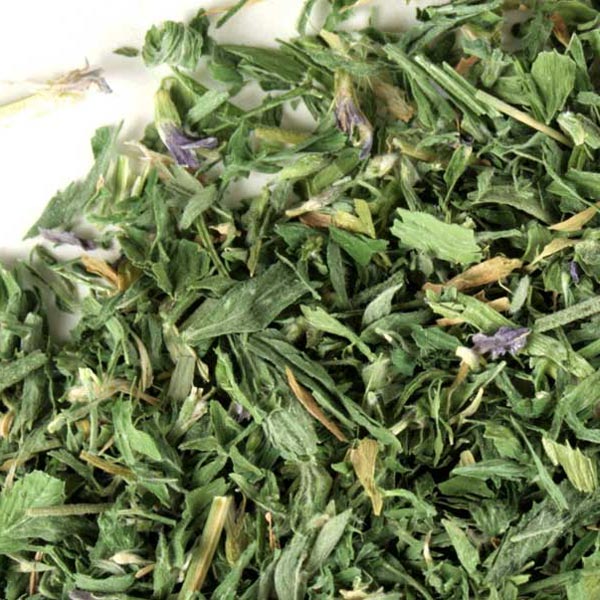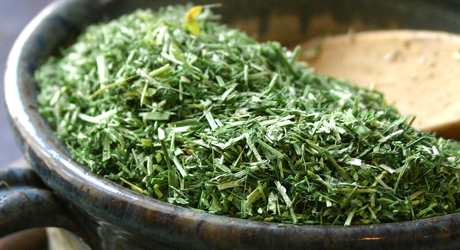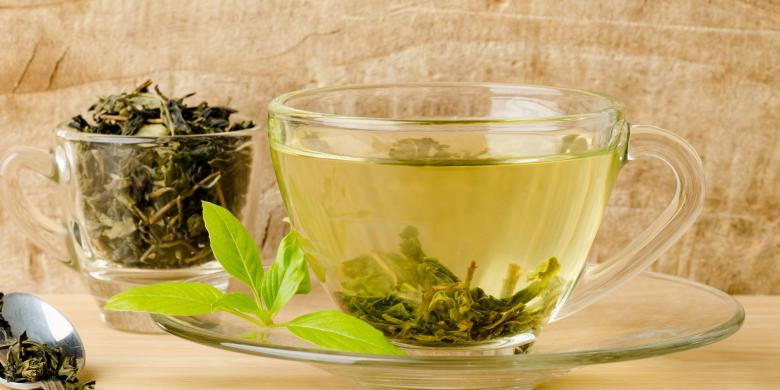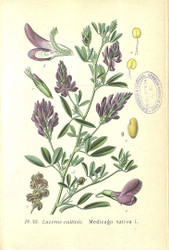Herbal Monograph: ALFALFA (Medicago sativa)
Posted by T. Schuur | Community Herbalist | Aromatherapist | Botanical Chemistry & Formulation | Integrative Health Practitioner on 30th Apr 2020
ALFALFA Medicago sativa
Known as "The Herbal Thouroughbred"
Latin Binomial
Medicago sativa
Common Name
Alfalfa, buffalo grass, Chilean clover, purple medic, lucerne
Family
Fabaceae
TCM Name
Mu-su
Ayurvedic Name
Lusan
Parts Used
Leaves, flowers, seeds, and sprouts
Native To
Southeast Asia and Southeast Europe
Key Constituents
The key constituents of alfalfa include steroidal saponins, sterols, coumarins, flavonoids, isoflavones, coumestral analogues, alkaloids, proteins, estrogens, and variety of vitamins and minerals including vitamins B, C, E, K, calcium, iron, magnesium, phosphorous, and potassium (Khaleel et al., 2005; Schneider, 2002).
Sustainability Issues
Because of its commercial cultivation, along with its widespread naturalization, alfalfa is in no way threatened.

Harvesting Guidelines
Harvest alfalfa leaves just as the plant begins to bloom. Cut back the plant within 3 inches of the ground, using the fresh leaves or hanging the herb in bundles to dry. Multiple harvests are possible in a single season. Promptly process alfalfa, since it begins to break down quickly when left in direct sunlight. Under optimal conditions, it takes two days to dry alfalfa leaves (Carpenter and Carpenter, 2015).
Adult Dose
Capsules: 3-4, 370mg 3x/day (Duke, 2000)
Tincture: 15-30 drops 4x/day (Duke, 2000)
Infusion: 1-2 teaspoons of dried alfalfa leaves in a cup of boiling water 3x/day (Duke, 2000)
Safety
Alfalfa sprouts and seeds contain an amino acid known as canavanine, a substance that can cause lupus-like symptoms and trigger flare-ups for those who already have systemic lupus erythematosus. Excessive consumption of alfalfa seeds has also been linked to pancytopenia, a condition in which the body’s red and white blood cell production decreases, as well as skin irritations and gastrointestinal problems. Pregnant and nursing women, people with autoimmune conditions, or those taking prescription anticoagulants, should avoid alfalfa (Chillemi and Chillemi, 2013; Johnson and Foster, 2006).
Ways to Use
Raw, Capsules, Tincture, Tablets, Infusion (Hot or Cold)

Therapeutic Actions
- Alterative (strengthens and nourishes the body, often through the removal of metabolic wastes)
- Cardiotonic (increases strength and tone (normal tension or response to stimuli) of the heart)
- Digestive (promotes or aids the digestion process)
- Diuretic (increases urine flow)
- Estrogenic (can cause the production of estrogen)
- Galactagogue (promotes the flow of a mother's milk)
- Hemostatic (controls or stops the flow of blood)
- Laxative (loosens bowel contents)
- Nutritive (a herb containing nutrients required to nourish and build the body)
- Restorative (a herb that restores health, strength or well-being)
- Stomactic (aids the stomach and digestive action)
- Tonic (stimulates energy and increases strength and tone)
Taste
- Bitter
- Salty
Herbal Energetics
- Cooling
Therapeutic Uses
Nutrient Tonic:
Alfalfa contains eight essential amino acids; vitamins A, E, K, B, D; phosphorus; iron; potassium; chlorine; sodium; silicon; magnesium; and beta carotene.
Fitness and Weight Control:
Alfalfa is a natural diuretic and laxative to ease water retention, cleanse your system, improve digestion, and keep your intestinal tract in fit condition. Because of these values, alfalfa has been used as an aid for weight loss.
Vitamin K:
Alfalfa is a source of vitamin K, which is necessary for blood clotting, carbohydrate storage, liver vitality, and longevity. Normally, vitamin K is manufactured by your body’s intestinal flora as a by-product of digestion and stored for use. Your body only needs small amounts of vitamin K, and there is rarely a lack of it, except in certain circumstances. Habitual use of aspirin, alcohol, or drugs can destroy your vitamin K supply. In addition, lingering intestinal disorders like colitis can hamper your intestinal flora’s ability to make vitamin K. Antibiotics can destroy vitamin K along with friendly flora. In these cases, alfalfa tea can give you the tune-up you need.
Revered For:
- Leaves
- Flowers
- Fodder (Animal)
- Seeds
- Sprouts
Good Source Of:
- Vitamin B
- Vitamin C
- Vitamin E
- Vitamin K
- Calcium
- Iron
- Magnesium
- Phosphorous
- Potassium
- Protein

Alfalfa most likely came to North America via Spanish explorers, and later, with gold prospectors from South America who carried alfalfa seeds to California. It wouldn’t be cultivated as staple crop in the United States until sometime in the 1860’s (Ritchason, 1995).
While its history may be well-documented, the etymological roots of its name are less clear. In the Middle East, alfalfa was known as al-fac-facah, which means “father of all foods.” The French name for alfalfa, lucerne, means “the plant that glitters,” though early French writers also referred to alfalfa as sain foin, which translates as “healthy hay.” The Greek geographer Strabo referred to alfalfa as mdich, so called because of its origin in the ancient Median Empire, a name which persists in its genus, Medicago (Schneider, 2002; Russelle, 2001).
Collectively, the variations on alfalfa’s names testify to its longstanding value as an animal fodder. However, alfalfa’s contemporary value in herbal preparations is less widely accepted.
Alfalfa is native to Arabia (al-fac-facah / father of all foods), and is a member of the legume family. With it’s small, split leaves; purple flowers like clovers; and unusual spiral pods it’s become a common sight on the Canadian prairies! It has long roots that reach deep into the soil for minerals.
Arabian horses are among the most prized breeds in the world, and it was through them that alfalfa’s virtues were first discovered by the Arabians. When they saw that alfalfa made their horses swift and strong, the Arabians began to take alfalfa themselves. Henceforth, the herb became known as The Father of All Foods.
Variously celebrated and ignored, alfalfa nevertheless has a long history of human use. In Traditional Chinese Medicine, alfalfa has a history of use for urinary and digestive imbalances. Records trace alfalfa back to 200 A.D. to the Han Dynasty, when it was used to soothe stomach ulcers (Chillemi and Chillemi, 2013).
Ayurveda considers alfalfa a cooling plant, with its leaves and flowering tops used as a galactagogue and to ease the discomforts of poor digestion, water retention, and arthritis. The seeds are also made into a poultice and used to draw out boils (Foster and Johnson, 2006).
After alfalfa's arrival in the United States in the mid-1800s, Native American tribes began using crushed alfalfa seeds to thicken food and the tender shoots of the plant as a vegetable. Some tribes have employed alfalfa infusions for jaundice and to encourage blood clotting. The Ohlone have a history of using heated alfalfa leaves as a poultice for easing the pain of ear infections (Chillemi and Chillemi, 2013).
English herbalist John Gerard suggested alfalfa for upset stomachs, while Colombians have traditionally used it for soothing coughs (Ritachason, 1995). In the 19th century, the Eclectics used alfalfa as a tonic for indigestion, dyspepsia, and anemia. Due to alfalfa’s high protein content, it was also used for appetite loss or to help mediate malnutrition (Chillemi and Chillemi, 2013).
Today, most people are probably familiar with alfalfa as a food source in its sprouted form. Alfalfa is more than a salad bar staple, however. Used as the basis for liquid chlorophyll, alfalfa mimics the chemical and mineral constituents in hemoglobin. It also contains high levels of vitamin K, beta carotene, fluoride, and an appreciable amount of calcium. Alfalfa is also used in herbal plans to support arthritis, intestinal complaints, troubled skin, liver problems, diabetes, high cholesterol, and cancer (Ritchason, 1995).

James Duke (1991/2007) explains that alfalfa is one of the richest sources of easily-assimilated proteins, vitamins, and minerals available to us. For this reason, alfalfa is often considered more food than herb. This, along with its enduring use as an animal fodder, may explain the scarcity of clinical trials that focus on the health benefits of alfalfa in herbal preparations. Though few, studies on alfalfa indicate that it is a powerful anti-bacterial, as well as a potent antioxidant.
In a 2011 study (Doss, et al.), researchers prepared a series of alfalfa extracts, using petroleum ether, benzene, chloroform, methanol, and ethanol as solvents. They also prepared a highly-concentrated aqueous extract.
Each extract was tested against seven microbial pathogens, including Staphylococcus aureus, Streptococcus pyogens, Proteus mirabilis, Escherichia coli, Pseuodomonas aeruginosa, Klebsiella pneumonia, and Salmonella typhi.
Researchers determined the antimicrobial activity of each extract by measuring the diameter of zone inhibition around colonies prepared on agar plates. As a control, researchers tested pure solvents, rather than extracts, against each bacterial strain.
The benzene and petroleum ether alfalfa extracts had little inhibitory effect on the pathogens, though chloroform, methanol, and ethanol demonstrated significant antibacterial activity. The ethanol extract had the largest inhibition zone against all seven pathogens the researchers tested.
Significantly, the ethanol alfalfa extract was more effective against the Gram-positive bacteria (Staphylococcus aureus and Streptococcus pyogens) than against the Gram-negative bacteria used in this study. Researchers attribute this result to the tannins in alfalfa which attack the cellular structure of Gram-positive bacteria.
In another widely-cited study (Mölgaard, 1987) patients with hyperlipoproteinemia received 40 grams of alfalfa seeds 3 times a day for 8 weeks, while making no other dietary changes. After eight weeks, researchers saw a median decrease in total plasma cholesterol from 9.58 to 8.00 mmol/1 (P < 0.001) and a decrease in low-density lipoprotein (LDL) cholesterol from 7.69 to 6.33 mmol/1 (P < 0.01). The most significant decrease was 26% in total cholesterol and 30% in LDL cholesterol, though two study participants with hypercholesterolemia lowered their LDL by less than 5%.
Interestingly, after participants stopped taking the alfalfa seeds, their lipoprotein concentrations returned to pretreatment levels. As such, researchers concluded that alfalfa seeds can help normalize serum cholesterol concentrations in patients with hyperlipoproteinemia, but that their use must be continuous.
Like a number of studies on alfalfa, however, the population sample for this clinical trial was small—at just 15 participants. Though the cholesterol-lowering effects of alfalfa seeds seem promising, more research into alfalfa’s bodily influence is necessary.

Alfalfa is a super brew to use for energy and staying power, and peppermint brings flavour and synergy to tea. Used together and optionally with a dried citrus fruit like orange peel, you create a formula for energy, sustenance, synergy, immune enhancing and overall pure enjoyment! A tea such as this can be sipped hot or cold and enjoyed year round!
Citrus Alfalfa Mint Tea Formula
1pt dried alfalfa
1pt dried peppermint
0.5pt dried orange peel
Blend all herbs together and pour 1.5 - 2.0 cups boiling water over. Allow to steep 7-12 minutes. Drink hot infusion or pour the blend into a tall glass filled with ice to enjoy a refreshing cold brew.
Source: Zak, Victoria. 20,000 Secrets of Tea . Random House Publishing Group. Kindle Edition. | Source: The Herbarium
